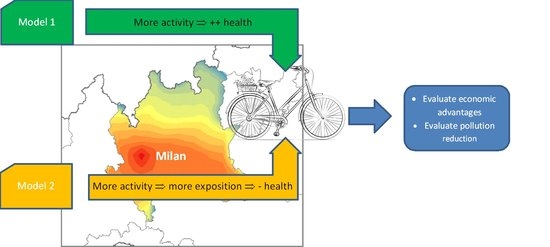Assessing the Value of Systematic Cycling in a Polluted Urban Environment
Abstract
1. Introduction
1.1. Effetcs of Biking on Human Health
1.2. The Case of Milan
2. Materials and Methods
2.1. Cycling Benefits Model
- The number of cyclists or the amount of trips in terms of average trips per person per day or of the total number of trips observed each day in the studied area; in this case, the proportion of trips that are return journeys needs to be entered;
- The average time or the average distance spent by bike per person every day. One factor can be transformed into the other by assuming a constant value for speed. HEAT assumes by default a speed value of 14 km/h, on the basis of studies about usual trips to work/study places in Copenhagen and Stockholm [36];
- The number of days per year when the sample uses a bicycle;
- The current mortality rate expressed as the number of deaths for every 100,000 inhabitants;
- The standard value of statistical life, namely an indicator of the economic value of human life;
- The time period over which economic benefits are calculated (equal to 10 years by default);
- The discount rate (by default, this value is set to 5%) to account for the delay between the starting of the physical activity and realisation of the corresponding benefits;
- If available, the cost to promote cycling mobility.
- The risk reduction in mortality;
- The reduction in mortality levels within the sample population;
- The maximum and mean annual benefits and their current values; and
- The total benefit accumulated over 10 years and its current value.
2.2. Cycling Costs Model
- The mean annual concentration of PM10 in the area of interest;
- The average trip duration in minutes or distance travelled in kilometres;
- The current mortality rate;
- The number of people exposed to air pollution, that, in our case, is the number of cyclists;
- The relative risk (, estimating the number of cases of death attributable to an increase of 10 μg/m3 in PM10 concentration; and
- The ventilation rate, which assumes higher values for activity characterised by higher energy expenditure, such as cycling.
2.3. Analysis of Diffferent Scenarios
2.3.1. Trip Duration
2.3.2. Day per Year
2.3.3. Mortality Rate
2.3.4. Standard Value of Statistical Life
2.3.5. RR10
2.3.6. Ventilation Rate
2.3.7. Current Scenario
2.3.8. 2024 Scenario
2.3.9. Improved Air Quality Scenario
2.3.10. Amsterdam Scenario
3. Results
3.1. Cost–Benefit Anaysis
3.2. Effects on CO2 and PM10 Emissions
4. Discussion and Conclusions
Acknowledgments
Author Contributions
Conflicts of Interest
References
- ECF. EU Cycling Strategy. Recommendations for Delivering Green Growth and Effective Mobility System in 2030. 2017. Available online: https://ecf.com/sites/ecf.com/files/EUCS_full_doc_small_file.pdf (accessed on 5 July 2107).
- Tainio, M.; De Nazelle, A.J.; Götschi, T.; Kahlmeier, S.; Rojas-Rueda, D.; Nieuwenhuijsen, M.J.; Hérick De Sá, T.; Kelly, P.; Woodcock, J. Can air pollution negate the health benefits of cycling and walking? Prev. Med. 2016, 87, 233–236. [Google Scholar] [CrossRef] [PubMed]
- Woodward, A.; Samet, J. Active transport: Exercise trumps air pollution, almost always. Prev. Med. 2016, 87, 237–238. [Google Scholar] [CrossRef] [PubMed]
- Tainio, M.; Monsivais, P.; Jones, N.; Brand, C.; Woodcock, J. Mortality, Greenhouse Gas Emissions, and Consumer Cost Impacts of Replacing Short Car Trips with Cycling: A Health Impact Assessment Study. J. Transp. Health 2017, 5, S71. [Google Scholar] [CrossRef]
- Kaufman, R. Novel air pollution study gauges individual cyclists’ risks. Eos 2017, 98, 13. [Google Scholar] [CrossRef]
- Lonati, G.; Ozgen, S.; Ripamonti, G.; Signorini, S. Variability of Black Carbon and Ultrafine Particle Concentration on Urban Bike Routes in a Mid-Sized City in the Po Valley (Northern Italy). Atmosphere 2017, 8, 40. [Google Scholar] [CrossRef]
- Vlachokostas, Ch.; Achillas, Ch.; Michailidou, A.V.; Moussiopoulos, Ν. Measuring combined exposure to environmental pressures in urban areas: An air quality and noise pollution assessment approach. Environ. Int. 2012, 39, 8–18. [Google Scholar] [CrossRef] [PubMed]
- Spinazzè, A.; Cattaneo, A.; Peruzzo, C.; Cavallo, D.M. Modeling Population Exposure to Ultrafine Particles in a Major Italian Urban Area. Int. J. Environ. Res. Public Health 2014, 11, 10641–10662. [Google Scholar] [CrossRef] [PubMed]
- Spinazzè, A.; Cattaneo, A.; Scocca, D.R.; Bonzini, M.; Cavallo, D.M. Multi-metric measurement of personal exposure to ultrafine particles in selected urban microenvironments. Atmos. Environ. 2015, 110, 8–17. [Google Scholar] [CrossRef]
- Xu, L.; Ren, C.; Yuan, C.; Nichol, J.E.; Goggins, W.B. An Ecological Study of the Association between Area-Level Green Space and Adult Mortality in Hong Kong. Climate 2017, 5, 55. [Google Scholar] [CrossRef]
- INRIX. Traffico in Calo in Italia per il Secondo Anno Consecutivo. 2016. Available online: http://inrix.com/press-releases/scorecard-it/ (accessed on 5 July 2107).
- CamCom (Camera di Commercio, Industria e Artigianato di Milano). 2003. Available online: http://www.mi.camcom.it (accessed on 5 July 2107).
- De Nazelle, A.; Nieuwenhuijsen, M.J.; Antó, J.M.; Brauer, M.; Briggs, D.; Braun-Fahrlander, C.; Cavill, N.; Cooper, A.R.; Desqueyroux, H.; Fruin, S.; et al. Improving health through policies that promote active travel: A review of evidence to support integrated health impact assessment. Environ. Int. 2011, 37, 766–777. [Google Scholar] [CrossRef] [PubMed]
- Celis-Morales, C.A.; Lyall, D.M.; Welsh, P.; Anderson, J.; Steel, L.; Guo, Y.; Maldonado, R.; Mackay, D.F.; Pell, J.P.; Sattar, N.; et al. Association between active commuting and incident cardiovascular disease, cancer, and mortality: Prospective cohort study. BMJ 2017, 375, j1456. [Google Scholar] [CrossRef] [PubMed]
- Robinson, M.M.; Dasari, S.; Kanopka, A.R.; Carter, R.E.; Lanza, I.R.; Sreekumaran Nair, K. Enhanced Protein Translation Underlies Improved Metabolic and Physical Adaptations to Different Exercise Training Modes in Young and Old Humans. Cell Metab. 2017, 25, 581–592. [Google Scholar] [CrossRef] [PubMed]
- ECF. The EU Cycling Economy—Arguments for an Integrated EU Cycling Policy. European Cyclists’ Federation, Brussels. 2016. Available online: https://ecf.com/groups/eucycling-economy (accessed on 5 July 2107).
- Dockery, D.W.; Pope, C.A., III; Xu, X.; Spengler, J.D.; Ware, J.H.; Fay, M.E.; Ferris, B.G., Jr.; Speizer, F.E. An Association between Air Pollution and Mortality in Six U.S. Cities. N. Engl. J. Med. 1993, 329, 1753–1759. [Google Scholar] [CrossRef] [PubMed]
- Brunekreef, B.; Holgate, S.T. Air pollution and health. Lancet 2002, 360, 1233–1242. [Google Scholar] [CrossRef]
- Pope, C.A., III; Dockery, D.W. Health Effects of Fine Particulate Air Pollution: Lines that Connect. J. Air Waste Manag. Assoc. 2006, 56, 709–742. [Google Scholar] [CrossRef] [PubMed]
- Khafaie, M.; Yajnik, C.; Salvi, S.; Ojha, A. Critical review of air pollution health effects with special concern on respiratory health. J. Air Pollut. Health 2016, 1, 123–136. [Google Scholar]
- Viaene, P.; Belis, C.A.; Blond, N.; Bouland, C.; Juda-Rezler, K.; Karvosenoja, N.; Martilli, A.; Miranda, A.; Pisoni, E.; Volta, M. Air quality integrated assessment modelling in the context of EU policy: A way forward. Environ. Sci. Policy 2016, 65, 22–28. [Google Scholar] [CrossRef]
- Landrigan, P.J. Air pollution and health. Lancet Public Health 2017, 2, e4–e5. [Google Scholar] [CrossRef]
- Vardoulakis, S.; Fisher, B.E.A.; Pericleous, K.; Gonzalez-Flesca, N. Modelling air quality in street canyons: A review. Atmos. Environ. 2003, 37, 155–182. [Google Scholar] [CrossRef]
- Dominici, F.; Peng, R.D.; Barr, C.D.; Bell, M.L. Protecting Human Health from Air Pollution: Shifting from a Single-Pollutant to a Multi-pollutant Approach. Epidemiology 2010, 21, 187–194. [Google Scholar] [CrossRef] [PubMed]
- Billionnet, C.; Sherrill, D.; Annesi-Maesano, I. Estimating the Health Effects of Exposure to Multi-Pollutant Mixture. Ann. Epidemiol. 2012, 22, 126–141. [Google Scholar] [CrossRef] [PubMed]
- Künzli, N.; Kaiser, R.; Medina, S.; Studnicka, M.; Chanel, O.; Filliger, P.; Herry, M.; Horak, F., Jr.; Puybonnieux-Texier, V.; Quénel, P.; et al. Public-health impact of outdoor and traffic-related air pollution: A European assessment. Lancet 2000, 356, 795–801. [Google Scholar] [CrossRef]
- Blengio, G.; De Noi, L.; Falcone, S.; Manservisi, S. La valutazione del rischio sanitario correlato all’inquinamento atmosferico nei centri urbani. Azienda ULSS 22 Regione Veneto Direzione Sanitaria 2014, 5–31. [Google Scholar]
- FIAB Milano Ciclobby. 13 Censimento dei Ciclisti Milanesi. 2014. Available online: http://www.ciclobby.it (accessed on 5 July 2107).
- Comune di Milano. Piano Urbano Della Mobilità Sostenibile. Milano. Documento di Piano. 2015. Available online: http://comune.milano.it (accessed on 5 July 2107).
- Fietsberaad. The Bicycle Capitals of the World: Amsterdam and Copenhagen. Publication no. 7a. 2010. Available online: http://www.fietsberaad.nl (accessed on 5 July 2107).
- Amsterdam Marketing, the City Marketing Organisation of the Amsterdam Metropolitan Area. Available online: www.iamsterdam.com (accessed on 21 August 2107).
- Environmental and Mobility Agency of Milan (AMAT). Available online: www.amat-mi.it (accessed on 5 July 2107).
- World Weather and Climate Information. Available online: www.weather-and-climate.com (accessed on 21 August 2107).
- World Health Organization (WHO). Health Economic Assessment Tools (HEAT) for Walking and for Cycling. Economic Assessment of Transport Infrastructure; WHO Regional Office for Europe: Copenhagen, Denmark, 2014. [Google Scholar]
- World Health Organization (WHO). Development of the Health economic assessment tools (HEAT) for walking and cycling. In Proceedings of the Consensus Workshop: Meeting Report, Bonn, Germany, 1–2 October 2013; WHO Regional Office for Europe: Copenhagen, Denmark, 2014. [Google Scholar]
- Schantz, P.; Stigell, E. Distance, time and velocity as input data in cost-benefit analyses of physically active transportation. In Proceedings of the 2nd International Congress of Physical Activity and Public Health, Amsterdam, The Netherlands, 13–16 April 2008; p. 270. Available online: http://www.gih.se/mhe (accessed on 5 July 2107).
- Bigazzi, A.Y. Determination of active travel speed for minimum air pollution inhalation. Int. J. Sustain. Transp. 2017, 11, 221–229. [Google Scholar] [CrossRef]
- World Health Organization (WHO). Economic Valuation of Transport-Related Health Effects. Review of Methods and Development of Practical Approaches, with Special Focus on Children; WHO Regional Office for Europe: Copenhagen, Denmark, 2008. [Google Scholar]
- Rojas-Rueda, D.; De Nazelle, A.; Tainio, M.; Nieuwenhuijsen, M.J. The health risks and benefits of cycling in urban environments compared with car use: Health impact assessment study. BMJ (Clin. Res. Ed.) 2011, 343. [Google Scholar] [CrossRef] [PubMed]
- Grabow, M.L.; Spak, S.N.; Holloway, T.; Stone, B., Jr.; Mednick, A.C.; Patz, J.A. Air quality and exercise-related health benefits from reduced car travel in the midwestern United States. Environ. Health Perspect. 2012, 120, 68–76. [Google Scholar] [CrossRef] [PubMed]
- Lombardy Regional Census Report. Available online: www.asr-lombardia.it (accessed on 5 July 2107).
- Ozgen, S.; Ripamonti, G.; Malandrini, A.S.; Ragetti, M.S.; Lonati, G. Particle number and mass exposure concentrations by commuter transport modes in Milan, Italy. AIMS Environ. Sci. 2016, 3, 168–184. Available online: http://www.aimspress.com/article/10.3934/environsci.2016.2.168 (accessed on 5 July 2107). [CrossRef]
- Environmental Agency of the Lombardy Region. Available online: www2.arpaLombardia.it/sites/QAria (accessed on 5 July 2107).
- Lombardy Region Air Emission Inventory. Available online: http://inemar.arpalombardia.it (accessed on 5 July 2107).
- Regione Lombardia, Piano Regionale degli Interventi per la Qualità dell’Aria, 2013. Available online: http://www.regione.lombardia.it (accessed on 22 August 2107).
- FIAB (Federazione Italiana Amici della Bicicletta) Onlus. Usare la Bicicletta nelle aree Urbane. Posizione ufficiale dell’EFC European Cyclists’ Federation. 2008. Available online: http://www.fiab-onlus.it/downl2/cycling.pdf (accessed on 5 July 2107).
- WHO. Unlocking New Opportunities: Jobs in Green and Healthy Transport; World Health Organisation, Regional Office for Europe, WHO Regional Office for Europe: Copenhagen, Denmark, 2014. [Google Scholar]
- De Hartog, J.J.; Boogaard, H.; Nijland, H.; Hoek, G. Do the health benefits of cycling outweigh the risks? Environ. Health Perspect. 2010, 118, 1109–1116. [Google Scholar] [CrossRef] [PubMed]
- Jacobsen, P.L. Safety in numbers: More walkers and bicyclists, safer walking and bicycling. Inj. Prev. 2003, 9, 795–801. [Google Scholar] [CrossRef]
- Guglieri, V.; Silva, G. La Ciclabilità in Lombardia: Questione Politica o Sviluppo Infrastrutturale? Bachelor’s Thesis, Politecnico di Milano, Milan, Italy, 2016. [Google Scholar]
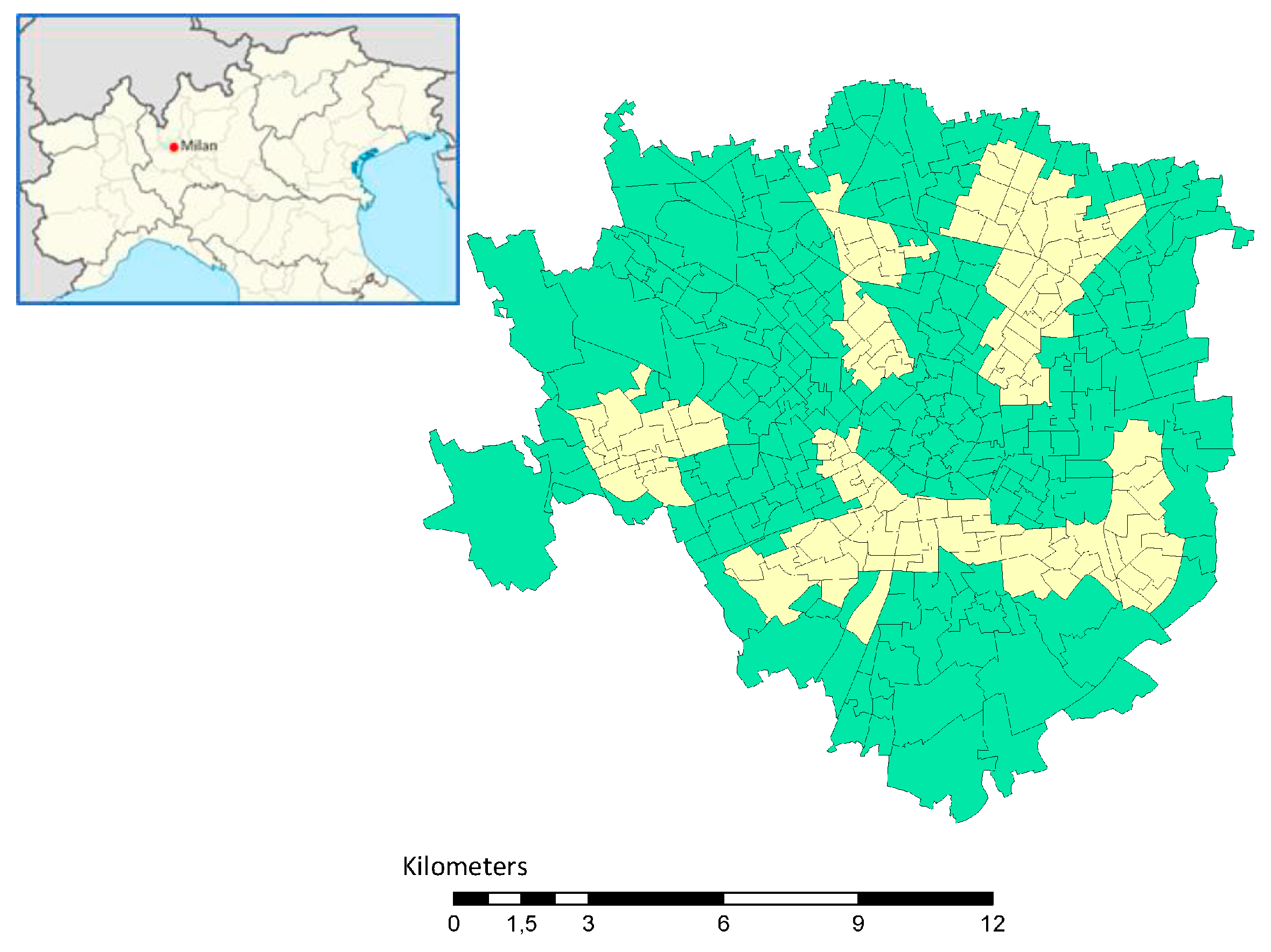

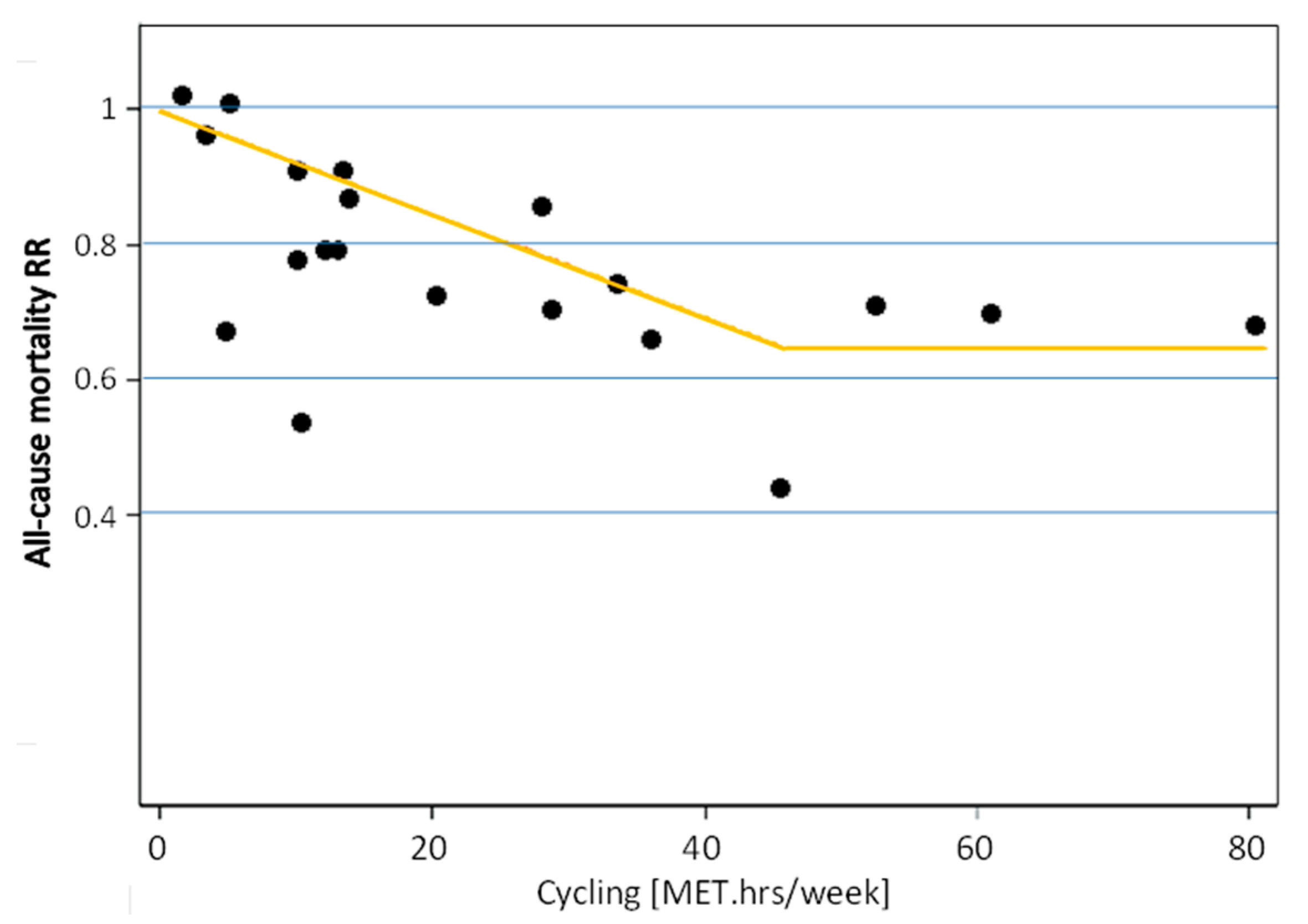
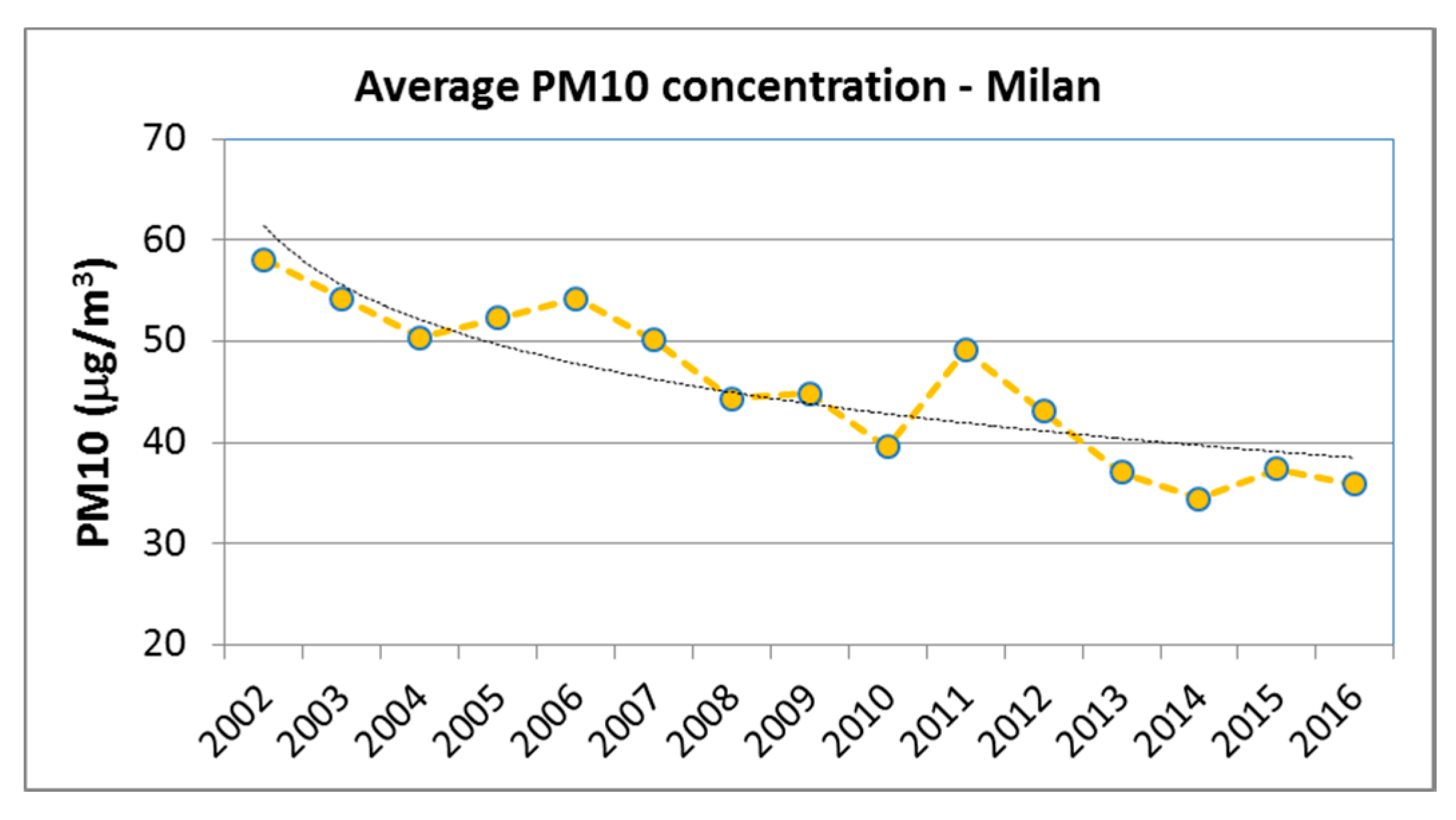
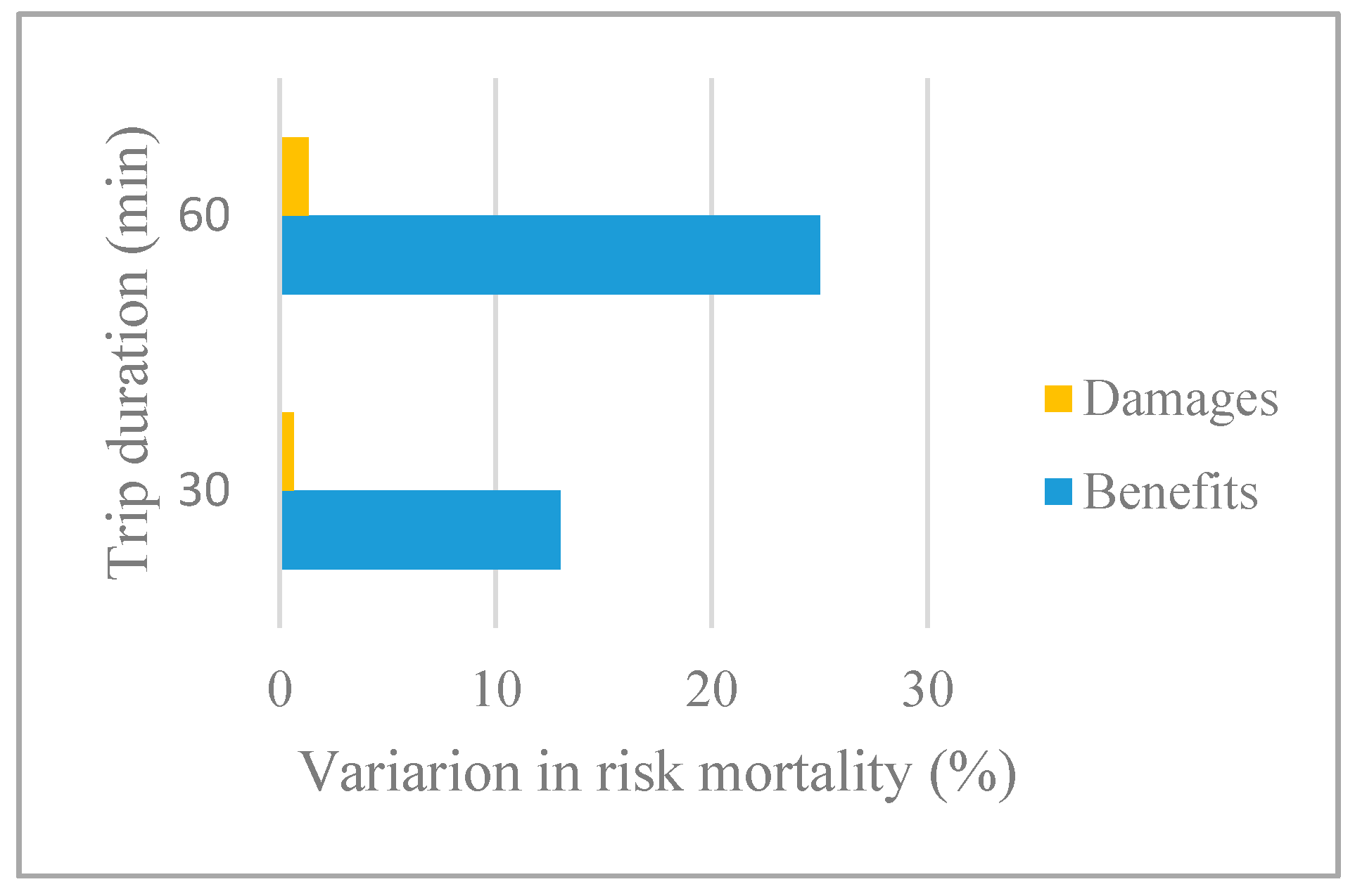
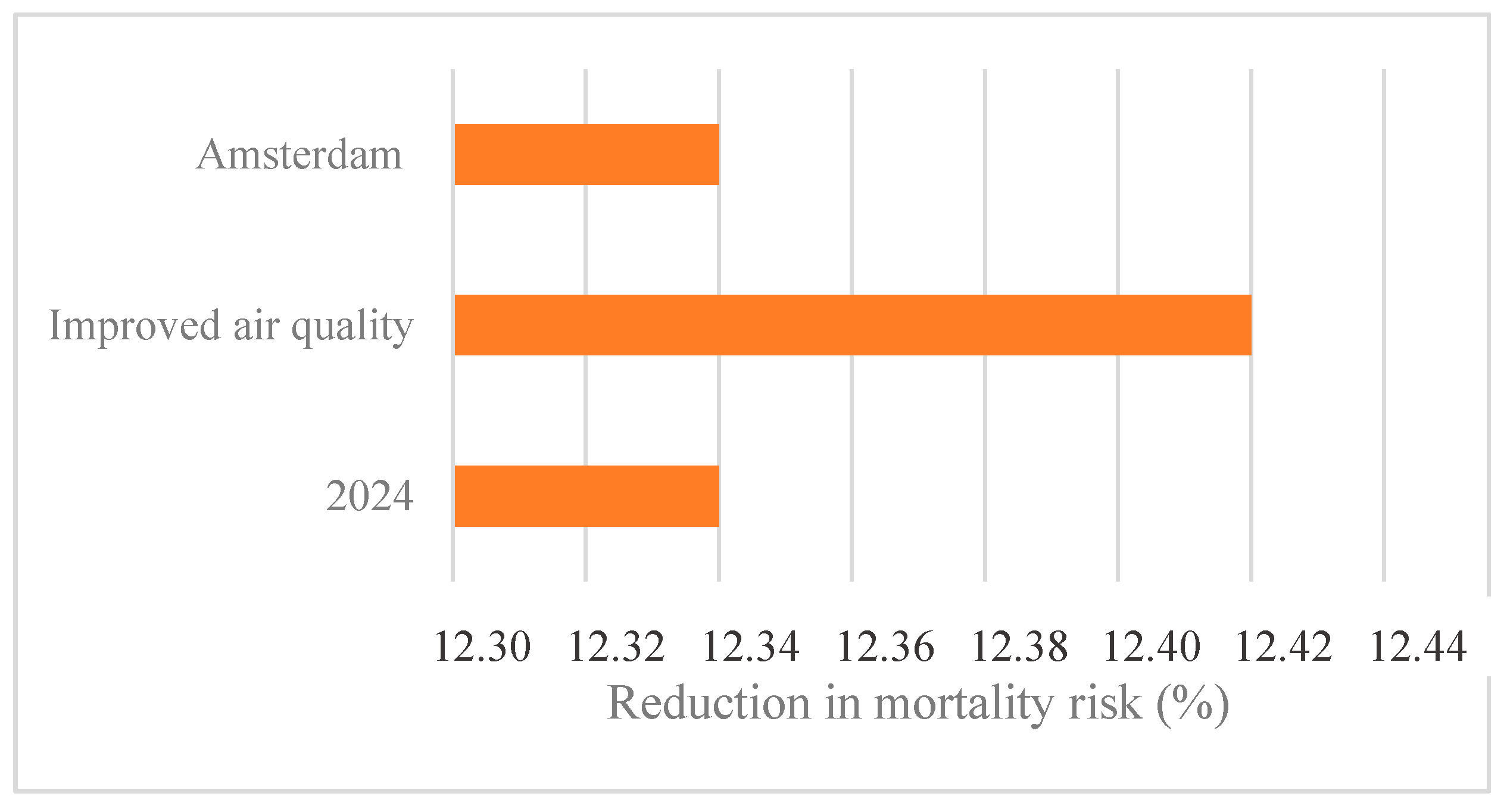
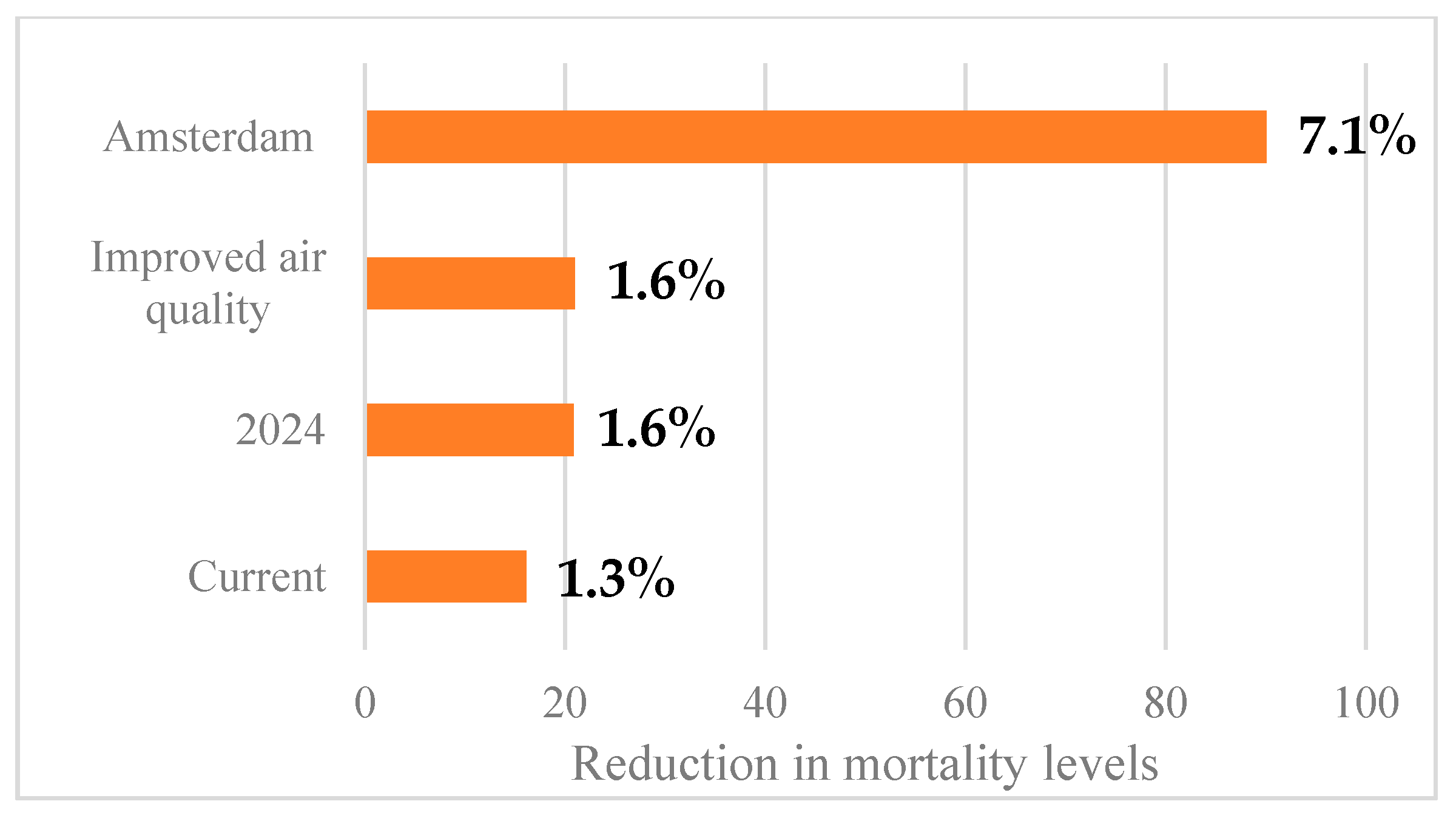
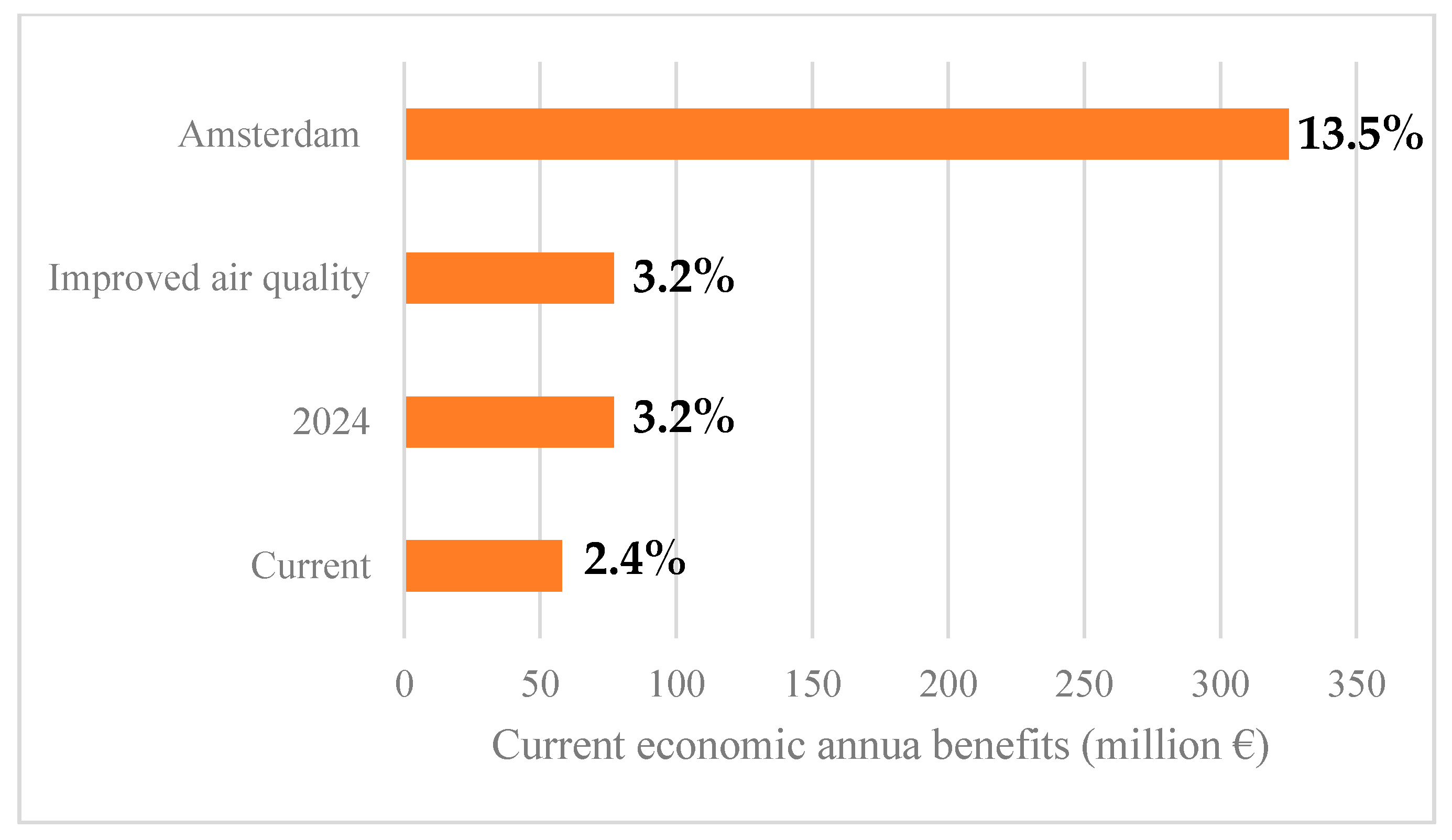
| Trip Duration by Bike (Min/Day) | 30–60 |
| Trip duration by car (min/day) | 26–52 |
| Activity days/year | 220 |
| Base mortality rate (death/100,000 inhabitants) | 157.2 |
| VSL (million €) | 4.7 |
| Discount rate (%) | 5 |
| RR10 | 1.043 |
| Ventilation rate at rest (m3/h) | 0.54 |
| Ventilation rate when biking (m3/h) | 2.28 |
| Ventilation rate when driving (m3/h) | 0.66 |
| Bicycle 8 km/h (m3/h) | 1.5 |
| Bicycle 19.3 km/h (m3/h) | 3 |
| 2024 | Improved Air Quality Scenario | Amsterdam Scenario | ||
|---|---|---|---|---|
| Variation in mortality risk (%) | HEAT | 13 | 13 | 13 |
| R-R | 0.66 | 0.58 | 0.66 | |
| Variation in mortality level | HEAT | 22 | 22 | 95 |
| R-R | 1 | 1 | 5 | |
| Average annual value (M€) | HEAT | 81 | 81 | 343 |
| R-R | 4.2 | 3.7 | 18 | |
| Economic value over 10 years (M€) | HEAT | 813 | 813 | 3440 |
| R-R | 43 | 37 | 181 | |
| Benefits/Damages ratio | 19 | 22 | 19 | |
| Average Emission Factor | ||
|---|---|---|
| CO2 (g/km) | PM10 (mg/km) | |
| Petrol | 180.46 | 26.26 |
| Diesel | 167.51 | 79.77 |
| Number of Cars Replaced by Bike | ||
|---|---|---|
| Petrol | Diesel | |
| ∆scenario current-2024 | 17,368 | 9324 |
| ∆scenario current-Amsterdam | 243,997 | 121,670 |
| CO2 | ∆Scenario Current-2024 | ∆Scenario Current-Amsterdam | PM10 | ∆Scenario Current-2024 | ∆Scenario Current-Amsterdam |
|---|---|---|---|---|---|
| t/year | 7600 | 100,000 | t/year | 2 | 28 |
| % | 0.60 | 7.7 | % | 0.59 | 8.3 |
© 2017 by the authors. Licensee MDPI, Basel, Switzerland. This article is an open access article distributed under the terms and conditions of the Creative Commons Attribution (CC BY) license (http://creativecommons.org/licenses/by/4.0/).
Share and Cite
Guariso, G.; Malvestiti, G. Assessing the Value of Systematic Cycling in a Polluted Urban Environment. Climate 2017, 5, 65. https://doi.org/10.3390/cli5030065
Guariso G, Malvestiti G. Assessing the Value of Systematic Cycling in a Polluted Urban Environment. Climate. 2017; 5(3):65. https://doi.org/10.3390/cli5030065
Chicago/Turabian StyleGuariso, Giorgio, and Giulia Malvestiti. 2017. "Assessing the Value of Systematic Cycling in a Polluted Urban Environment" Climate 5, no. 3: 65. https://doi.org/10.3390/cli5030065
APA StyleGuariso, G., & Malvestiti, G. (2017). Assessing the Value of Systematic Cycling in a Polluted Urban Environment. Climate, 5(3), 65. https://doi.org/10.3390/cli5030065





